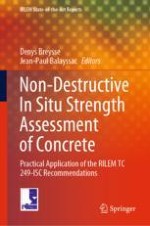
2021 | OriginalPaper | Chapter
1. In-Situ Strength Assessment of Concrete: Detailed Guidelines
Authors : Denys Breysse, Jean-Paul Balayssac, Maitham Alwash, Samuele Biondi, Leonardo Chiauzzi, David Corbett, Vincent Garnier, Arlindo Gonçalves, Michael Grantham, Oguz Gunes, Said Kenaï, Vincenza Anna Maria Luprano, Angelo Masi, Andrzej Moczko, Hicham Yousef Qasrawi, Xavier Romão, Zoubir Mehdi Sbartaï, André Valente Monteiro, Emilia Vasanelli
Published in: Non-Destructive In Situ Strength Assessment of Concrete
Publisher: Springer International Publishing
Activate our intelligent search to find suitable subject content or patents.
Select sections of text to find matching patents with Artificial Intelligence. powered by
Select sections of text to find additional relevant content using AI-assisted search. powered by